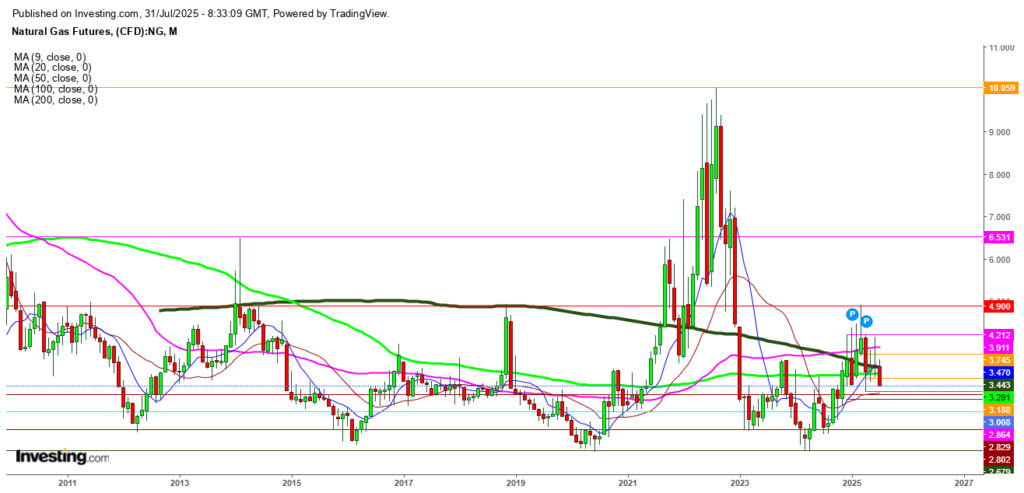The dynamics of natural gas prices are subject to a multitude of factors ranging from weather patterns to geopolitical policies. A thorough examination of price movements across various time frames suggests a potential for reversal in the prices of natural gas; however, this seems to be a couple of months away. The price structure at present, characterized by an excess in storage and a shift towards milder summer temperatures, indicates that prices are likely to bottom out around September at approximately $1.972. This period of low prices is expected to persist until the onset of winter, setting the stage for a price reversal.
Moreover, the flip in prices is not solely contingent upon weather-driven demand but is also significantly influenced by the outcomes of tariff policies, particularly those enacted by former US President Donald Trump. During his term, Trump embarked on a strategy to recalibrate the global energy market, notably by imposing higher tariffs on Asian nations purchasing oil and gas from Russia and other suppliers. This maneuver aimed to control the changing energy supply landscape and had a profound impact on natural gas pricing and distribution.
The period from April to June witnessed an above-normal rate of inventory buildup for natural gas, attributed to the mild spring weather, robust supply chains, extensive maintenance of LNG (Liquefied Natural Gas) facilities, and a reduction in power burns compared to the previous year. However, this buildup has somewhat plateaued as natural gas futures continue their downward trajectory. The July storage levels aligned more closely with seasonal norms, and with summer reaching its end and predictions of a milder August, it sets an unusual precedent for entering the winter of 2025-26 with higher-than-average inventories. Consequently, natural gas futures may revisit the lows experienced in March of the same year, oscillating between $1.476 and $3.291, before potentially embarking on an upward trajectory by December 2025. This anticipated increase is in response to a forecasted rise in demand in the first half of the next year, compounded by investment levels that remain inadequate to meet the swelling demand for LNG in 2026.
Technical Levels to Watch
On the technical front, analyses of monthly and weekly charts provide insights into natural gas futures. In a monthly view, after President Trump declared a national energy emergency upon his inauguration in January 2025, followed by the initiation of trade tariff disputes, an exhaustive hammer pattern was identified, succeeded by a confirmatory bearish candle this month. This pattern suggests that natural gas futures may continue their bearish trend for the next two to three months.
Additionally, weekly chart reviews reveal attempts by natural gas futures to hold above the 200-Day Moving Average (DMA) at $3.881. Despite achieving a peak of $4.900 in the second week of March 2025, the futures have since dropped, with key DMAs (9, 20, 50, and 100) trading below the 200 DMA. A breakdown below the 50 DMA indicates readiness for the prices to challenge the next support level at the 100 DMA at $2.875.
Turning to the daily chart, natural gas futures are trading below the 9 DMA at $3.114, with bearish crossovers marked by the 9 DMA piercing through the 20 DMA, both of which have already breached the 50 DMA. This points to the possibility of the fall extending to the significant support level at $2.864, where a rebound might be anticipated.
Disclaimer: The information provided in this analysis is based on market observations. Readers are advised to exercise discretion and undertake any positions in natural gas futures at their own risk.
This narrative emphasizes not just the technical and geographical aspects influencing natural gas prices but also the socio-political dimensions, enhancing understanding for readers irrespective of their familiarity with ongoing news or the commodities market. It serves as a comprehensive guide to navigating the complexities of the natural gas markets, underpinned by detailed technical analysis and the broader implications of policy decisions on global energy supplies and pricing dynamics.



